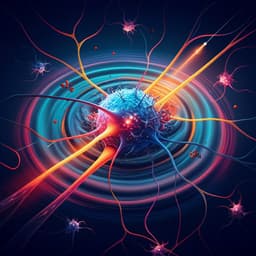
Medicine and Health
Metastability indexes global changes in the dynamic working point of the brain following brain stimulation
R. Bapat, A. Pathak, et al.
New analysis shows single-pulse TMS transiently reduces brain metastability and increases coherence, defining a measurable window of altered neural coordination; higher EEG frequencies recover faster and Lempel‑Ziv complexity confirms reduced dynamical complexity. Using public datasets and a whole‑brain digital twin, the study reveals how local phase resetting can propagate globally. This research was conducted by Rishabh Bapat, Anagh Pathak, and Arpan Banerjee.
~3 min • Beginner • English
Introduction
Processing the complex dynamic environment requires flexible exploration of neural coordination states, a property captured by metastability—the system’s tendency to traverse multiple attractors. Modeling work suggests metastability is a signature of the brain’s dynamic core and is maximized at rest. Empirical studies show metastability changes with states of consciousness and pathology: it is reduced during loss of consciousness, after traumatic brain injury, and in Alzheimer’s disease, but increased in schizophrenia and under psychedelics. These observations link metastability to cognitive flexibility and raise the question of whether such changes arise from principled network dynamics.
Transcranial Magnetic Stimulation (TMS) induces local phase resetting, transiently enforcing coordinated states. From a dynamical systems perspective, entry into an attractor reduces dimensionality and thus metastability. Therefore, even a single TMS pulse could reduce metastability, offering a potential index to describe stimulation effects and standardize/optimize protocols (with implications for other NIBS methods like tDCS/tACS).
The study tests the hypothesis that metastability is reduced in a time window time-locked to a TMS pulse and that recovery to pre-stimulus levels indexes the perturbation duration, potentially varying by frequency. A complementary whole-brain Kuramoto “digital twin” is used to elucidate mechanisms underlying empirical findings.
Literature Review
The paper situates metastability as central to brain function, referencing foundational and contemporary work that identifies it as a hallmark of the brain’s dynamic core and maximized at rest. Prior studies link altered metastability to states of consciousness and disease: decreases in metastability during loss of consciousness, post-traumatic brain injury, and in Alzheimer’s disease; increases in schizophrenia and under psychedelics, with implications for cognitive flexibility. TMS is known to produce local phase resets that propagate through networks, suggesting that stimulation can transiently constrain coordination dynamics. This background motivates metastability as a sensitive, mechanistically grounded index to quantify and contextualize the network-level impact of brain stimulation protocols.
Methodology
Data: Two OpenNeuro datasets were analyzed. Dataset 1: 20 healthy participants (6 female, 14 male; mean age 30), 32-channel BrainVision EEG at 5 kHz; 300 s resting-state EEG; then 600 monophasic single-pulse TMS at 120% RMT over right primary motor cortex (left FDI hotspot) with 5 s inter-pulse interval; simultaneous EEG; short breaks every 100 pulses. Dataset 2: 13 healthy right-handed participants (18–85 years), 64-channel BrainVision EEG at 20 kHz; 300 s resting-state; 75 TMS pulses at 100% RMT and 110% RMT (5 s ISI) over right M1; simultaneous EEG. Coil noise not masked; earplugs provided.
Preprocessing: Implemented in MATLAB (EEGLAB) and Python (MNE); code available in associated Bitbucket. Resting EEG: Artifact Subspace Reconstruction plus MARA-based ICA rejection. TMS-EEG: ARTIST automated artifact rejection pipeline. All data downsampled to 1 kHz and bandpass filtered 1–100 Hz.
Metastability measures: (1) Kuramoto Order Parameter (KOP) variability. EEG was narrow-band filtered (e.g., 8–12 Hz), instantaneous phase via Hilbert transform; KOP computed per time point; standard deviation (SD) of KOP in a 50 ms sliding window used as dynamic metastability index. Metastability time series averaged over epochs and participants. Channel grouping to probe local effects: For each intensity, compute averaged TMS-evoked response across epochs/subjects, identify time of peak Global Field Power (GFP), z-score channels relative to mean, sort by deviation, and assign top/bottom tertiles to two ROIs, capturing channels with most extreme evoked differences (fronto-central and temporo-occipital clusters). Analyses were performed for all channels and for ROIs.
(2) Microstate sequence complexity via Lempel-Ziv Complexity (LZC). Microstates derived from GFP peaks in alpha-band (8–12 Hz) resting data using Topographical Atomise and Agglomerate Hierarchical Clustering (TAAHC). For each participant, number of microstates selected using the Krzanowski-Lai criterion on Correlation Sum (typically 4–8). Subject-specific templates were back-fitted to resting and TMS-EEG data. LZC computed for the resulting microstate label sequence in 100 ms sliding windows, averaged across epochs and subjects, and compared between resting and TMS conditions.
Statistics: For pre/post comparisons, two 250 ms windows were defined before and after the pulse. Epoch-averaged measures were averaged within windows to obtain participant-level pre vs post values. Given n<30 and mixed normality (Shapiro-Wilk), Wilcoxon Signed-Rank tests (one-tailed; alpha=0.05) assessed hypothesized directional changes.
Computational modeling: Whole-brain Kuramoto network of 90 oscillators (AAL parcellation), with coupling and time delays informed by structural connectivity (probabilistic tractography; connectivity from Cabral et al. 2014 averaged across subjects) and conduction distances (delays scaled by conduction velocity). Intrinsic frequencies assigned based on anatomical node strength (per Gollo et al. 2017). Additive Gaussian noise (mean 0, SD 1) scaled by factor 3. Coupling and conduction velocity chosen to yield metastable dynamics (assessed via KOP). TMS modeled as a phase reset to π/2 in stimulated and nearby regions (defined via SimNIBS electric field); remaining regions reset according to conduction delay from stimulation site. Pulses delivered at low-coherence states (identified by peak finding) to standardize initial state. Metastability (SD of KOP) computed in a 500 ms sliding window; coherence (KOP) also tracked. Simulations run for frequency distributions capped at 5, 15, 25, and 35 Hz with fixed dispersion and other parameters; outputs averaged over 20 random seeds. Analyses also performed on a subgroup of oscillators with intrinsic frequencies similar to right M1, analogous to empirical ROIs.
Key Findings
- Channel grouping identified two TMS-affected sensor clusters: a fronto-central and a temporo-occipital group, spatially consistent with stimulation site (right M1) and induced electric field.
- Metastability (SD of KOP) decreased by approximately 10–40% following single-pulse TMS across frequency bands, indicating a transient reduction in coordination variability. Higher frequencies (alpha, beta, gamma) recovered within ~200 ms; lower frequencies (delta, theta) recovered within ~400 ms. A ~10% pre-pulse increase in metastability was observed across bands; in alpha and theta, post-recovery exceeded baseline by ~10–15%.
- Coherence (KOP) effects varied by scale: globally, KOP decreased by ~10% post-pulse, whereas within ROIs, a sharp KOP increase accompanied the metastability reduction. Effects replicated across intensities (100%, 110%, 120% RMT). Figure 3 shows fronto-central ROI at 120% RMT.
- Wilcoxon Signed-Rank tests for KOP (fronto-central, 120% RMT): Decrease after pulse was significant for delta (stat=200, p<0.001), theta (210, p<0.001), gamma (202, p<0.001), and all bands combined (205, p<0.001), but not alpha (88, p=0.73) and trend-level for beta (146, p=0.06). Pre-pulse KOP increase significant across individual bands (e.g., delta stat=6, p<0.001; theta 2, p<0.001; alpha 21, p<0.001; beta 26, p<0.001; gamma 13, p<0.001), but not for all bands combined (149, p=0.951). Post-pulse KOP increases significant for theta (55, p=0.031), alpha (17, p<0.001), beta (48, p=0.016); not for delta (162, p=0.985), gamma (82, p=0.204), or all bands (197, p=0.999).
- Microstate analysis: Optimal number of microstates per subject was 4–8; backfitting explained variance was slightly lower post-TMS than rest (0.60–0.65) but adequate. Post-TMS microstate dynamics showed increased variance in state durations and polarized transition probabilities, suggesting repeated consolidation into specific patterns during reduced metastability. LZC increased prior to the pulse (stat=22, p=0.002), decreased after TMS (stat=138, p=0.01), and recovered to baseline by ~200 ms.
- Modeling reproduced empirical signatures: TMS-induced phase resetting increased coherence (KOP) and reduced metastability, followed by recovery. Recovery of metastability was faster for higher intrinsic frequencies and slower for lower frequencies, mirroring empirical EEG band-specific dynamics.
Discussion
Findings support the hypothesis that single-pulse TMS transiently constrains the brain’s coordination dynamics, reducing metastability in a time-locked window after stimulation. This is consistent with a dynamical systems view where TMS drives local populations into more synchronized, low-dimensional states that propagate through the structural connectome via delays, producing local synchronization and global desynchronization patterns. The microstate results confirm decreased sequence complexity and polarized transitions, indicating repeated consolidation into specific coordination states under reduced metastability.
The whole-brain Kuramoto model clarifies mechanisms: a phase reset within the stimulated region propagates along delayed structural pathways, briefly stabilizing network coordination and reducing metastability; recovery speed scales with intrinsic frequency, explaining the faster recovery in higher-frequency EEG bands. The observed pre-pulse increase in metastability likely reflects anticipation, supported by the presence of a stimulus-preceding negativity and the unmasked TMS click.
Practically, metastability provides a sensitive index to characterize the temporal window of altered coordination dynamics after stimulation, offering a means to time cognitive task probes relative to TMS and to standardize/optimize stimulation protocols. Given the relevance of metastability to multiple neuropathologies, protocol optimization based on metastability modulation could enhance therapeutic outcomes compared with simpler synchrony metrics like coherence.
Conclusion
This study demonstrates that single-pulse TMS induces a robust, time-locked reduction in metastability of large-scale brain dynamics, with recovery that is frequency dependent (faster for higher EEG bands). Convergent evidence from KOP variability and microstate LZC, together with a whole-brain Kuramoto model, reveals that transient phase resetting and delayed network propagation underlie these effects. Metastability thus serves as a mechanistically grounded index for quantifying network-level perturbations induced by brain stimulation.
Future work should: (1) leverage metastability to time cognitive task interventions and to standardize/optimize stimulation protocols (including rTMS, tDCS, tACS); (2) further examine anticipatory contributions to pre-pulse dynamics and their neurophysiological basis; (3) extend modeling to diverse protocols and individualized connectomes; and (4) assess clinical utility by targeting disorders with altered metastability and tracking therapeutic modulation over longer timescales.
Limitations
- Anticipation confound: The TMS click was not masked; a stimulus-preceding negativity was observed, and pre-pulse increases in metastability likely reflect anticipation, potentially influencing baseline comparisons.
- Sample sizes per dataset were modest (<30), motivating non-parametric tests and possibly limiting statistical power in some bands/conditions.
- Microstate analysis was restricted to alpha-band-derived templates; backfitting explained variance was lower for TMS data than rest (0.60–0.65), which may affect microstate-based complexity estimates.
- Channel ROIs were derived algorithmically from evoked responses at peak GFP; while quantitative, ROI definitions may depend on evoked-response characteristics and may not generalize across montages.
- Modeling choices (fixed parameter sets, frequency distributions, and simplified phase-reset implementation) abstract from full biophysical complexity; results illustrate mechanisms but are not subject-specific.
- Only single-pulse TMS was studied; longer-term effects (e.g., rTMS) on metastability were not directly tested here.
Related Publications
Explore these studies to deepen your understanding of the subject.







